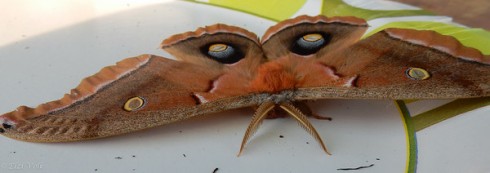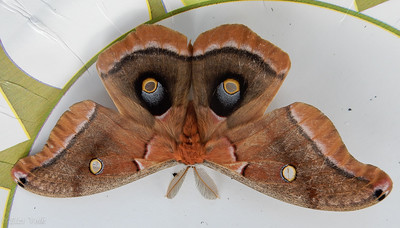
The early rising sun greeted us with a visitor in the damp grass one morning of a camping trip near New York’s Thousand Islands. As sunlight glistened on the blanketing dew, this large winged visitor rested on the grass waiting for moisture to evaporate off its wings and the sun to warm its body. It reminded me of another large moth, the luna moth (Actia luna), that I knew well during my life in the Maine woods.
The moth found on the wet grass that morning was a polyphemus moth (Antheraea polyphemus). Both moths are of the Giant Silkmoth family (Saturniidae). With a wingspan of up to six inches or more, the polyphemus moth is about the same size as a luna moth. These two species are the largest moths in continental America and may be found from Canada to northern Mexico.

Male polyphemus moth (antenna are larger than female’s)
Polyphemus moths are generalists, which means they do not require a specific species of plant for the larvae to develop and survive. Females lay flat brown eggs on many species of decidous trees: elm, birch, willow, maple, beech, locust and a variety of Prunus species (cherry, plum, peach, etc). Like many Lepidoptera, polyphemus larvae develop through five stages and molts (instar). Unlike monarch butterflies, of which the instars are very similar in coloration, these moths have slightly different coloration with each instar. The fifth and final instar is an average of four inches long and a bright green color with silver spots on its sides. A caterpillar can devour about 86,000 times its weight from emergence to full development in two months.
From the photos of the adult moth below one can see hair-like body scales, small head and mouth parts, and the eye spots on the wings. Because of their small mouth parts, adults do not eat and only live for a week or less, during which their entire purpose is to avoid depredation and reproduce.
Mimicry
Mimicry throughout the animal kingdom is an example of natural selection in evolution. Ranging from mammals to tiny insects, mimicry may increase survival of individuals in their environment. Or it may reduce survival in another environment.
Lepidoptera are fascinating examples of how mimicry enables survival. One tactic is to mimic another insect that may be undesirable prey. Another tactic is the patterns and structures on butterfly and moth wings that mimic a component of their environment to hide from depredation. These tactics may be adaptive defense mechanisms (or artifacts of other patterns of coloration) in response to threats. Our polyphemus moth will serve as an example of mimicry as a defense mechanism.
Distraction Pattern
Like many saturniids the polyphemus moth has large ‘eye spots’ on its hind wings. These wing eye spots are translucent ‘windows’ which may be surrounded by bright colors. The pair of eye spots on the polyphemus hind wing are bordered by bright colors and, with the entire wing pattern, may resemble eyes of a predator. These are distraction patterns, which is a form of mimicry. They may resemble eyes of a different animal and confuse or deceive potential predators.
Wing eye spots can be a form of self-mimicry and a distraction pattern: to draw a predator’s attention away from the most vulnerable body parts or to appear as an inedible or dangerous animal. When threatened, adult polyphemus moths flash their wings exposing the large hind wing eye spots to distract, startle, or scare off potential predators.

The centers of the eye spots lack scales, so they are transparent.
Another example of distraction pattern in mimicry is camouflage which helps avoid detection by predators. Eye spots and wing color patterns on adult polyphemus can serve as blending camouflage (color matching) and pattern camouflage (pattern matching) in their environment.
Unrelated to mimicry, these eye spots may also play a role in mate attraction, but this has not been conclusively confirmed.
 Mimicry is also exhibited by the polyphemus caterpillars. They can be protected from predators by their cryptic green coloration (another example of what kind of distraction pattern?). When threatened the caterpillars often raise the front part of the body up in a threatening pose. If attacked, the caterpillars make a clicking noise with the mandibles. This clicking is associated with a distasteful fluid exuded by the caterpillars which can cause regurgitation by the attacker. Some animals (squirrels, birds, other insects) are deterred by the ingestion and regurgitation and the clicking may serve as a warning.
Mimicry is also exhibited by the polyphemus caterpillars. They can be protected from predators by their cryptic green coloration (another example of what kind of distraction pattern?). When threatened the caterpillars often raise the front part of the body up in a threatening pose. If attacked, the caterpillars make a clicking noise with the mandibles. This clicking is associated with a distasteful fluid exuded by the caterpillars which can cause regurgitation by the attacker. Some animals (squirrels, birds, other insects) are deterred by the ingestion and regurgitation and the clicking may serve as a warning.
Mimicry and names
Since one of my interests is the etymology of animal binomial names (simply put, the naming of things), mimicry also plays a part in this moth’s name.
The four silkmoth species in the New World (the Americas) were assigned to either Telea or Metosamia genus. The polyphemus silkmoth in the Americas was first described and named by Dutch naturalist Pieter Cramer in 1776 as Telea polyphemus. Jacob Hübner, a German entomologist (1761-1826), assigned the Old World (endemic to Asia and Europe) silkmoths to the genus Antheraea in 1819. In 1952, American entomologist Charles Duncan Michener (1918-2015) systematically categorized the Telea and Metosamia in with Antheraea classification. All the silkmoths are now in one genus classification.
The Modern Latin genus name Antheraea likely derives from the Greek anthēros, meaning brightly colored, brilliant, or flowery. The Lepidoptera Antheraea type species (the species on which the description of a genus is based on, and with which the genus name remains associated during any taxonomic revision) is the beautiful and vibrantly-colored tasar silkworm (Antheraea mylitta, formerly Phalaena mylitta), named and characterized in 1773 by English entomologist Dru Drury. Although not a silkworm like the tasar species, the polyphemus is colorful and has similar eye spots.
Cramer’s choice of the species name was based on Polyphemus, the giant cyclops from Greek mythology who had a single large, round eye in the middle of his forehead. Cramer may have been reminded of the name because of the large eye spots in the middle of the hind wings.
And the commonly used name ‘sphinx’ moth? It could have arisen because of the behavior of threatened larvae. When they raise their heads and thoraxes up, the pose superficially resembles Egyptian sphinxes. Someone had imagination.
Of course, the family name Saturniidae also peaked my curiosity. The consensus is that it was based on the eye spots of some members of the family that contain concentric rings reminiscent of the planet Saturn. I’ll take that, too.






Nature is incredible – thanks for sharing…
Concurring with humanity777! Such wonderful exemplars of Giant Silkmoth indeed! I would therefore like to resonate with the spirit of your well-written and illustrated post by hyperlinking your post with mine at https://soundeagle.wordpress.com/2016/08/17/do-plants-and-insects-coevolve/
I have also hyperlinked another version of the post to yours at https://queenslandorchid.wordpress.com/2016/08/17/do-plants-and-insects-coevolve/
Happy December to all of you very soon!